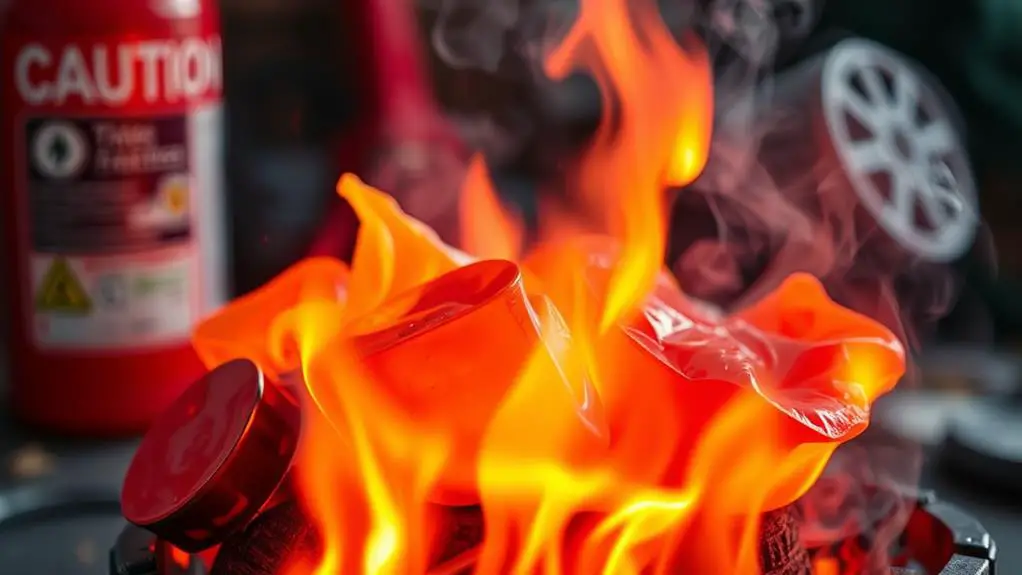Yes, plastic can catch fire, and it's important to know the basics. Most plastics ignite between 130-400°C, and some, like polyethylene and polystyrene, are particularly flammable. When they burn, they release toxic smoke and gases, which can be harmful to health. Common fire risks come from things like plastic dust or faulty batteries. To stay safe, regular maintenance and employee training are essential, plus using fire-retardant materials is a smart move. If you're curious about specific safety tips and regulations to keep in mind, there's more useful info just ahead.
Key Takeaways
- Most plastics can ignite at temperatures between 130-400°C, with polyethylene and polystyrene being particularly flammable.
- Burning plastics release toxic gases, including carbon monoxide and hydrogen cyanide, posing serious health risks.
- Plastic dust from manufacturing and faulty batteries can create ignition hazards in industrial environments.
- Regular maintenance of fire safety systems and employee training are essential for mitigating fire risks related to plastics.
- Compliance with fire safety regulations and standards helps reduce the risks associated with plastic combustion.
Flammability of Plastics
When it comes to fire safety, understanding the flammability of plastics is essential. Most plastics can catch fire when they're exposed to open flames. Their ignition temperatures usually range from 130-400°C, depending on the type. For instance, polyethylene (PE) ignites easily and burns rapidly, while polystyrene (PS) is super flammable and emits thick black smoke when burned. Additionally, plastic fire hazards can arise from everyday items like fluorescent bulbs or tea lights if not handled properly.
Different plastics behave differently during combustion. PVC is less flammable but can still ignite under the right conditions. When burning, plastics release a significant amount of heat, which can lead to rapid fire spreading. In fact, the heat release rate of burning plastics is often much higher than that of wood, increasing fire risks.
It's also crucial to know that burning plastics produce harmful byproducts, including toxic gases like carbon monoxide and hydrogen cyanide. These pose serious health risks. Some plastics come with flame retardants, but they don't make them completely safe.
Sources of Plastic Fires
Understanding how plastics catch fire sets the stage for recognizing where these fires can start. One major source of fire risk is the combustible plastic dust generated during the manufacturing process. This dust can ignite easily, leading to significant hazards.
If you're involved in hot work operations, like welding or cutting near plastic materials, be careful! Sparks can easily ignite nearby combustibles, escalating the danger. Additionally, some safety concerns with plastic tools highlight the risks associated with handling plastic products, particularly in environments where heat is present.
Combustible insulated panels in machinery can also harbor hidden fires, making them tricky ignition sources. You mightn't see the problem until it's too late. Additionally, faulty batteries housed in plastic casings can catch fire, especially when they're depleted or damaged during handling.
Don't forget about flammable substances, like solvents and lubricants, used in plastic manufacturing. These can easily ignite from various ignition sources, adding to fire hazards in the workplace.
To keep everything safe, it's crucial to understand these risks and be aware of flame retardant chemicals that can help reduce fire spread. Being proactive about fire safety can make a huge difference in avoiding accidents involving plastic fires.
Fire Risk Mitigation Strategies
Fire risk mitigation is all about taking smart steps to keep your workplace safe from plastic-related fires.
First off, make sure you regularly maintain your sprinkler systems; they're crucial for effective fire control, especially in plastic manufacturing. You don't want them to fail during an emergency!
Conducting infrared inspections can also help you spot hidden electrical hazards that could lead to fires. It's a smart move.
Employee training in fire safety protocols is essential too. Equip your workers with the knowledge to respond effectively if a fire breaks out.
Don't forget to collaborate with local fire departments for facility walk-throughs. They can help you identify potential fire hazards and improve your overall safety measures.
Developing strong fire risk mitigation plans is vital for preventing operational interruptions and enhancing safety in your facility.
Consider using safety products designed for fire resistance, and focus on reducing the amount of flammable materials around.
Health Risks From Burning Plastics
Burning plastics can release a cocktail of harmful chemicals that pose serious health risks. When plastics ignite, they produce toxic smoke that contains substances like sulfur dioxide and hydrogen chloride. These can lead to respiratory issues and worsen cardiovascular diseases.
If you're exposed to this smoke, you might be putting yourself at a higher cancer risk too. Certain plastics give off carcinogenic substances when they burn, making the situation even scarier.
The Grenfell Tower fire is a harsh reminder of the dangers of burning plastics, especially in homes. A survey showed that UK firefighters face a 323% higher cancer rate than the general population, which really highlights the health risks linked to toxic fumes from burning plastics.
But it doesn't stop there. Burning plastics can also lead to chronic illnesses and even birth defects, which is why it's crucial to implement fire safety measures wherever plastics are present.
Regulations and Safety Standards
When it comes to keeping everyone safe from the dangers of plastics, regulations and safety standards play a crucial role.
These guidelines help ensure that fire risks are minimized in products made from plastic materials. Here are some key points to know:
- The National Fire Protection Association (NFPA) sets standards to regulate the flammability of plastics in various products.
- The European Union's REACH regulations focus on chemical safety, making manufacturers comply with fire risk assessments for plastic materials.
- Building codes often require fire-retardant materials in construction to lower fire hazards related to plastics.
- Compliance with ASTM standards is essential for ensuring that products meet safety requirements and mitigate fire risks.
Frequently Asked Questions
Does Plastic Catch Fire?
Yes, plastic can catch fire. It ignites easily when exposed to flames or high heat. Different types of plastic burn at various temperatures, and some release toxic smoke, so always handle it carefully around fire.
How Does Plastic Cause Many Fire Hazards?
Plastics pose plenty of perilous fire hazards. They're highly combustible, especially when exposed to heat or flames. Dust, faulty batteries, and ignitable liquids in manufacturing can spark serious fires you need to watch out for.
Is Plastic Fire Safe?
No, plastic isn't fire-safe. It can easily ignite and release harmful fumes. While some plastics have flame retardants, their effectiveness varies. Always consider safety regulations, especially in places where fire hazards are a concern.
Which Plastic Does Not Catch Fire?
Did you know that silicone can resist ignition, making it a favorite for high-temperature uses? While no plastic's completely fireproof, silicone's self-extinguishing properties give you peace of mind when dealing with heat.

